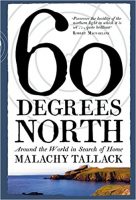Sixty Degrees North
by Malachy Tallack
(Polygon, £12.99)

In the library of the University of Uppsala in Sweden hangs the Carta Marina, one of the earliest accurate maps of the north of Europe. Printed in Italy in 1539, it was made by a Swede, Olaus Magnus, living in exile in Rome. Though many in Mediterranean Europe would then have imagined the north as a frozen waste, Magnus’s map is anything but: it teems with life — animal, marine and human. The cartographer’s intention, says Malachy Tallack, “was to do more than educate; it was to inspire a reimagining of place, and to turn southern heads toward the north”.
In Sixty Degrees North, Tallack turns his readers’ heads in the same direction. We join him on a trip along the 60th parallel, west from Shetland and, as the subtitle puts it, “Around the World in Search of Home”. It’s a gentler, more pleasurable journey for us than it has been for the writer, for this was a book “born in grief”.
When Tallack was 10, after his parents had split up, his mother took him and his brother from Sussex to Shetland. Having enjoyed holidays with relations there, he thought he would settle quickly, but he felt uprooted and unwelcome and was bullied at school. When he was 16, he decided to study music in London, and to live with his father — only to be robbed of a choice and a direction by his father’s death in a car accident.
He had no option but to return to the north. There, a few months later, prompted by a world map on the kitchen wall, he found himself daydreaming his way around the 60th parallel. More than a decade would pass — half of it spent away from Shetland — before he would set out to turn that dream into reality. In between, he went to university in Scotland and in Copenhagen and worked in Prague. When he went back to Shetland, it was by choice rather than necessity, but he still felt his relationship with the place had been tainted, and he imagined he could somehow change that by circling the parallel: “To make such a journey, in which the final, certain destination must be home, was an act of faithfulness. It was a commitment that, for the first time in my life, I felt ready to make.”
From Shetland, Tallack travels through Greenland, Canada, Alaska, Siberia, St Petersburg, Finland, Sweden and Norway. On the page it’s a continuous loop, but in practice it was a series of journeys. A trip to the Kamchatka Peninsula in Siberia, when he was 21 (he’s now in his thirties), was an early and formative one. He spent a day with the Even, nomadic herders, and watched them work together to slaughter a reindeer, skin it, and cut it up into fur and food before inviting him and his fellow visitors to share in the meat.
What he witnessed, he says, was a familiarity between people and place that was beyond what words could express. “There in Kamchatka, those people were not really separable from place… though I knew that such concordance is no longer truly possible in the world in which I live, in seeing it I felt for the first time its absence. And from there, from that recognition, my own longing took shape.”
On his way round the north, Tallack meets more people who seem to be at one with their environment and with each other, from native Inuit in Greenland, where there is no private land ownership, to recent arrivals in Alaska, who have left one home for another, bought a plot on “the last frontier” and found a deeper sense of belonging. In most places he visits, there’s a sense of man and nature being in harmony — St Petersburg being a notable exception. It’s a city built in defiance of nature; a place where Peter the Great imposed streets and roads on the islands and swamps of the Neva delta.
Tallack, not one for crowds, understandably doesn’t feel at home there, and flees its “noise and commotion” for a village 20 miles out. But can he, one wonders at times, ever truly feel at home anywhere? He fell in love with Kamchatka, but it was too far away. He fell in love again with Fair Isle, an island separated from Shetland by 25 miles of water, and with another community whose members are both self-reliant and interdependent. Through a local girl, he came to know it better, but for the last of his three years there he was “living alone, and that was a long way from ideal”, so he returned to Shetland.
This is far from being the travel journal of an introspective commitment-phobe. Tallack, however preoccupied with his own search, is always enlightening about where, how and why others have made their home in the north. His book, you realise from the outset, was painful to write (and it doesn’t end as neatly as the title of the last chapter, “Homecoming”, might suggest), but it’s a joy to read, its prose as clear as the light on the Greenland ice-cap. In the past year, I’ve read three or four books combining travelogue and memoir in which a writer, unmoored by loss, seeks a resolution of some kind on a journey; this was the best. MK
This review appeared in The Daily Telegraph on August 29, 2015
